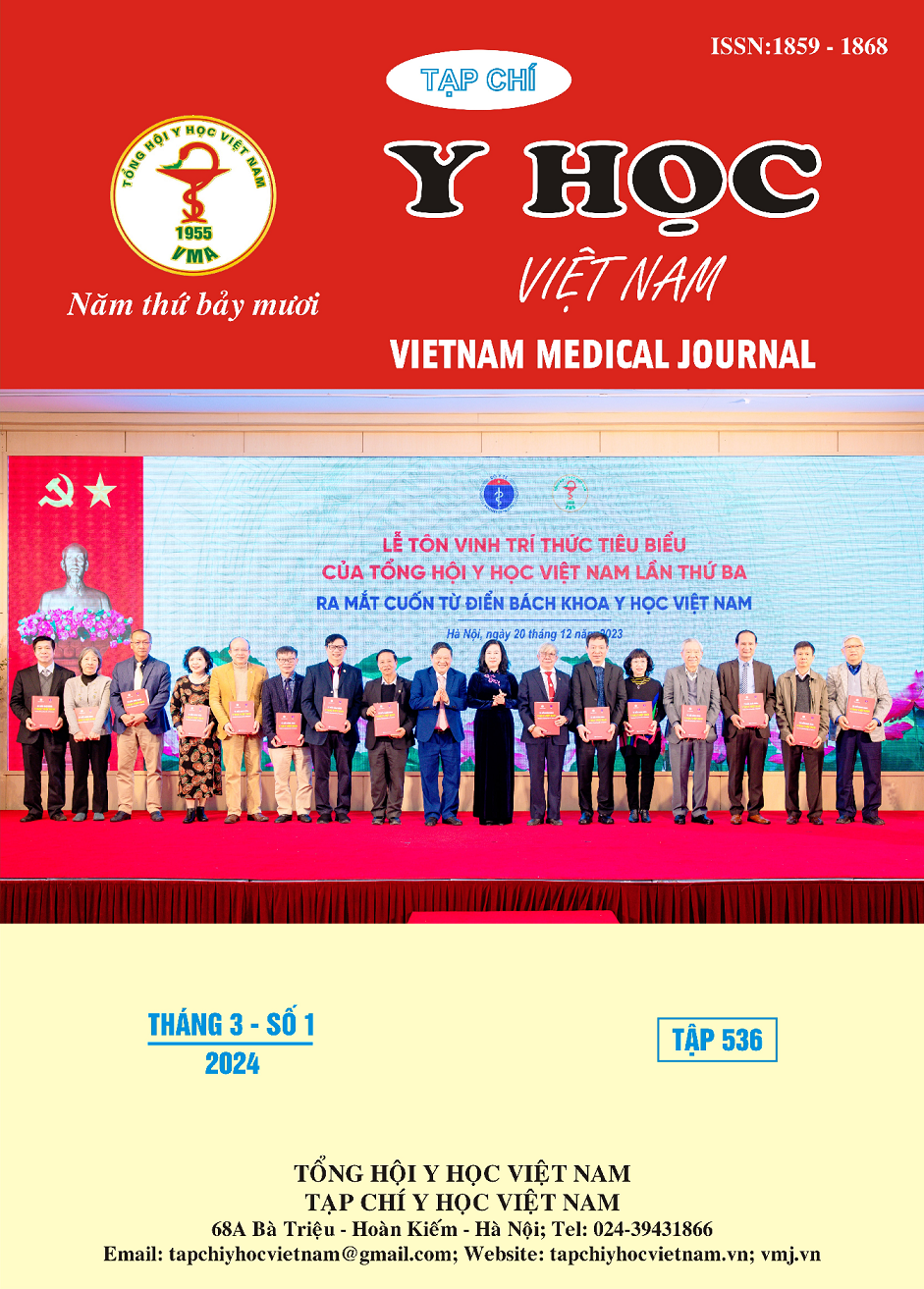KHẢO SÁT GIÁ TRỊ VIỆC KẾT HỢP DẤU HIỆU TỔN THƯƠNG XOANG MỘT BÊN VỚI ĐÁM MỜ XOANG HOÀN TOÀN, KHÔNG ĐỒNG NHẤT TRÊN CẮT LỚP VI TÍNH TRONG CHẨN ĐOÁN VIÊM XOANG DO NẤM
Nội dung chính của bài viết
Tóm tắt
Mục đích: Khảo sát giá trị việc kết hợp của tổn thương xoang một bên với đám mờ xoang hoàn toàn, không đồng nhất trên cắt lớp vi tính (CLVT) trong chẩn đoán viêm xoang do nấm (VXDN). Đối tượng và phương pháp nghiên cứu: Nghiên cứu mô tả trên 70 bệnh nhân viêm mũi xoang mạn tính đến khám tại Bệnh viện Đại học Y Hà Nội trong thời gian từ tháng 01 năm 2022 đến tháng 07 năm 2023. Các bệnh nhân này đều được nội soi và chụp CLVT đa dãy mũi xoang, sau đó được phẫu thuật nội soi xoang và chẩn đoán xác định VXDN bằng xét nghiệm nấm sau mổ. Các dấu hiệu tổn thương xoang một bên và đám mờ xoang hoàn toàn, không đồng nhất trên CLVT được kết hợp với nhau và đối chiếu với xét nghiệm nấm sau phẫu thuật nhằm khảo sát giá trị của việc kết hợp các dấu hiệu này. Kết quả: VXDN được chẩn đoán trên 60/70 bệnh nhân, chiếm tỷ lệ 86%. Trên CLVT, dấu hiệu vị trí tổn thương xoang một bên có độ nhạy, độ đặc hiệu, độ chính xác chẩn đoán, giá trị dự báo dương tính, giá trị dự báo âm tính đối với chẩn đoán VXDN lần lượt là 91,7%; 0%; 78,6%; 84,6%; 0%. Các giá trị này tương ứng đối với dấu hiệu đám mờ xoang hoàn toàn, không đồng nhất lần lượt là 80%; 20%; 71,4%; 85,7% và 14,3%. Khi kết hợp dấu hiệu vị trí tổn thương xoang 1 bên với dấu hiệu đám mờ xoang hoàn toàn, không đồng nhất, độ nhạy, độ đặc hiệu, độ chính xác, giá trị dự báo dương tính, giá trị dự báo âm tính của CLVT đối với chẩn đoán VXDN lần lượt là 70%; 60%; 68,6%; 91,3%; 25%. Kết luận: Kết hợp hai dấu hiệu đám mờ xoang hoàn toàn, không đồng nhất và một bên tuy giảm độ nhạy và giá trị chẩn đoán nhưng làm tăng độ đặc hiệu chẩn đoán VXDN bằng CLVT.
Chi tiết bài viết
Tài liệu tham khảo
2. Nicolai P, Lombardi D, Tomenzoli D, et al. Fungus ball of the paranasal sinuses: experience in 160 patients treated with endoscopic surgery. Laryngoscope 2009; 119(11):2275–9.
3. deShazo RD, O’Brien M, Chapin K, Soto-Aguilar M, Gardner L, Swain R. A new classification and diagnostic criteria for invasive fungal sinusitis. Arch Otolaryngol Head Neck Surg. 1997;123(11):1181-1188.
4. Aribandi M, McCoy VA et al. Imaging features of invasive and noninvasive fungal sinusitis: a review. Radiogr Rev Publ Radiol Soc N Am Inc. 2007;27(5):1283-1296.
5. Junaid Iqbal et al. Diagnostic Accuracy of CTScan in Diagnosing Paranasal Fungal Infection. Journal of the College of Physicians and Surgeons Pakistan 2017, Vol. 27 (5): 271-274
6. Lê Trung Nguyên. Nghiên Cứu Tình Hình Viêm Xoang Do Nấm Tại BV TMH TP. Hồ Chí Minh Từ Năm 2020-2021. Luận văn Ths. Đại học Y dược TP Hồ Chí Minh; 2021.
7. Mai Quang Hoàn. Khảo Sát Đặc Điểm Lâm Sàng, Cận Lâm Sàng và Điều Trị Viêm Xoang Do Nấm Tại Bệnh Viện Chợ Rẫy. Luận văn Ths. Đại học Y dược TP Hồ Chí Minh; 2018.
8. Jiang RS, Huang WC, Liang KL. Characteristics of Sinus Fungus Ball: A Unique Form of Rhinosinusitis. Clin Med Insights Ear Nose Throat. 2018;11:1179550618792254.
9. Dufour X, Kauffmann-Lacroix C, Ferrie JC, Goujon JM, Rodier MH, Klossek JM. Paranasal sinus fungus ball: epidemiology, clinical features and diagnosis. A retrospective analysis of 173 cases from a single medical center in France, 1989–2002. Med Mycol. 2006;44(1):61-67.
10. Lê Đức Đông. Nghiên Cứu Đặc Điểm Lâm Sàng, Cận Lâm Sàng và Đánh Giá Kết Quả Điều Trị Của Viêm Mũi Xoang Do Nấm. luận văn CK cấp II. Đại học Y Hà Nội; 2019.


